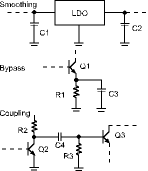Replacing tantalum with high capacitance MLCC
13 February 2002
Passive Components

Information from Murata
For several years there have been periodic variations in availability and price of tantalum capacitors. In the past this behaviour was due to political and economic strategies. Today, it is the poor supply of the tantalum raw material that is driving the Ta-capacitor crisis. At present we are seeing price growths up to 500% and the forecast is for further hikes. To help solve these difficulties Murata offers many ceramic capacitors that can directly replace electrolytic and tantalum types.
Figure 1 shows some basic circuits that need high capacitance values:
* Smoothing: The functions of C1 and C2 are to smooth the ripple and voltage fluctuations at the input and output of the LDO (low drop out regulator). C2's ESR and ESL are most important because they are responsible for the purity of the output voltage. In the past, high value Ta capacitors were used; now it is possible to use ceramic capacitors at a half to a tenth of the Ta values used previously.
* By-passing: C3 creates a 'virtual' ground for the transistor which 'believes' it is working at ideal conditions. The static and dynamic parameters are satisfied and the active device is properly used. The ESL of the cap is also most important in this case, and a low value avoids self-oscillation problems.
* Coupling: In order to link two stages (for example pre-amp to power amplifier) C4 is basic. This capacitor transfers only the signal and does not modify the DC parameters. For the example mentioned, it is most important that the capacitor is not polarised in order to avoid signal distortion.
What better solution than a ceramic capacitor? For more information on the technical characteristics of MLCCs and products available from Murata, contact your local distributor.
For further information contact Avnet Kopp, (011) 444 2333, [email protected] or www.avnet.co.za
Further reading:
Vibration-resistant axial capacitors
RS South Africa
Passive Components
TDK Corporation has unveiled the B41699 and B41799 series of ultra-compact aluminium electrolytic capacitors, engineered to withstand operating temperatures of up to 140°C.
Read more...
Capacitors for demanding industrial applications
Passive Components
TDK Corporation has announced its X1 capacitors of the EPCOS B3291xH/J4 series for power line filtering of electromagnetic interferences in demanding automotive and industrial applications with a rated AC voltage of up to 480 V.
Read more...
Wide frequency range inductors
RS South Africa
Passive Components
TDK Corporation has expanded its ADL4524VL series
(4,5 x 2,4 x 2,6 mm – L x W x H) of wire-wound inductors for automotive power-over-coax.
Read more...
Cutting-edge hybrid capacitors
Avnet Silica
Passive Components
Panasonic Industry recently announced the launch of the ZVU Series Hybrid Capacitors, a cutting-edge solution tailored to meet the escalating demands of advanced electronic systems.
Read more...
Low-profile tantalum chip capacitors
Electrocomp
Passive Components
These general-purpose tantalum capacitors from Kyocera AVX are available in multiple case sizes with low profile options.
Read more...
Coupled inductor for high-performance applications
Passive Components
This coil with MnZn core is characterised by its high permeability and extremely low RDC values, which achieves excellent power density and very high efficiency.
Read more...
Power inductors
iCorp Technologies
Passive Components
he HTF-MP series is more suitable for complex multiphase power supply applications in design, effectively meeting the needs of ultra-thin and high-power devices.
Read more...
SMT power inductors
Future Electronics
Passive Components
The Würth Elektronik WE-MXGI SMT power inductors are the latest addition to Würth Elektronik’s moulded power inductor series, engineered for high-frequency power applications.
Read more...
Large capacitance MLCCs at 100 V
RS South Africa
Passive Components
TDK Corporation has expanded its CGA series for automotive multilayer ceramic capacitors to 10 µF at 100 V in 3225 size.
Read more...
Film and mica capacitors
Actum
Passive Components
By utilising various polymer dielectrics plastics, Exxelia film and mica capacitors meet most technical requirements and serve all functions from standard filtering to specialised applications.
Read more...


